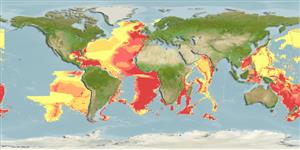Environment: milieu / climate zone / depth range / distribution range
Ecology
Marine; bathypelagic; depth range 300 - 618 m (Ref. 98298). Deep-water
Circumglobal, widespread. North Atlantic Ocean (both sides, including the Mediterranean Sea), the Pacific Ocean (off Japan, Philippines, the Sala-y-Gomez Ridge) and the Indian Ocean (east and west coasts of Australia and east coast of Africa).
Size / Weight / Age
Maturity: Lm ? range ? - ? cm
Max length : 39.6 cm TL male/unsexed; (Ref. 115012); max. published weight: 235.60 g (Ref. 115012)
This species is distinguished by the following set of characters: spinous first dorsal fin ray weakly serrated, more distinct near tip of ray; pelvic fin rays 7-10, usually 8-9; gill rakers first arch (outer/inner) 8-12/14-18; large barbel, its length 20-30% HL; short snout length 16-26% HL; very narrow suborbital 4-8% HL; upper jaw length 43-52% HL; a row of enlarged melanophores along lateral mid-line of the tail; cylindrical body (Ref. 97189).
Feeds on planktonic crustaceans (Ref. 6187).
Life cycle and mating behavior
Maturity | Reproduction | Spawning | Eggs | Fecundity | Larvae
McMillan, P. and T. Iwamoto, 2014. Descriptions of four species of grenadier fishes of the genera Hymenocephalus and Hymenogadus (Teleostei, Gadiformes, Macrouridae) from the New Zealand region and Tasman Sea, including two new species of Hymenocephalus. Zootaxa 3856:117-134.. (Ref. 97189)
IUCN Red List Status (Ref. 130435: Version 2024-1)
Threat to humans
Harmless
Human uses
Tools
Special reports
Download XML
Internet sources
Estimates based on models
Preferred temperature (Ref.
123201): 2.3 - 13, mean 9.9 °C (based on 221 cells).
Phylogenetic diversity index (Ref.
82804): PD
50 = 0.7500 [Uniqueness, from 0.5 = low to 2.0 = high].
Bayesian length-weight: a=0.00138 (0.00083 - 0.00229), b=3.22 (3.07 - 3.37), in cm total length, based on LWR estimates for this species & (Sub)family-body (Ref.
93245).
Trophic level (Ref.
69278): 3.1 ±0.30 se; based on food items.
Resilience (Ref.
120179): Medium, minimum population doubling time 1.4 - 4.4 years (Assuming tmax>3).
Fishing Vulnerability (Ref.
59153): Low to moderate vulnerability (30 of 100).
